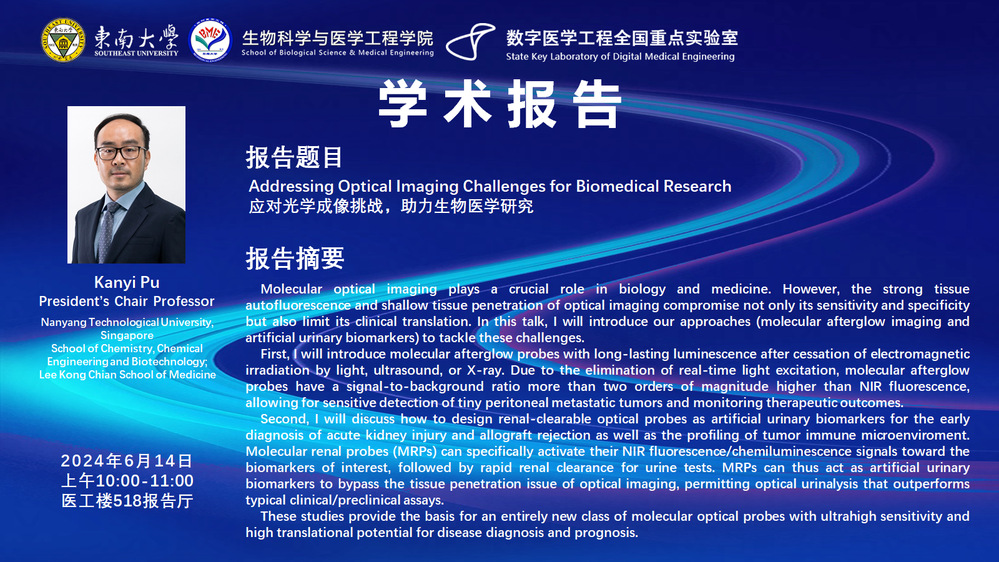报告题目:Addressing Optical Imaging Challenges for Biomedical Research (应对光学成像挑战,助力生物医学研究)
报告时间:
2024年6月14日(星期五)10:00-11:00
报告地点:
医工大楼518多功能厅
报告人简介:
Dr. Kanyi Pu is a President’s Chair Professor in the School of Chemistry, Chemical Engineering and Biotechnology (CCEB) and Lee Kong Chian School of Medicine at Nanyang Technological University (NTU). He serves as the Associate Dean for Research at the College of Engineering, one of the largest engineering schools in the world. With an h-index of 115 and over 36,000 citations, including 25 publications in Nature series journals, he is recognized as one of the world's most influential researchers by Web of Science and has earned prestigious honors, including the Singapore National Research Foundation (NRF) Investigatorship and Biomaterials Science Lectureship Award. He serves as the associate editor for ACS Applied Polymer Materials, Biomaterials Research, and Smart Molecules, as well as the editorial advisor broad member for more than 18 top journals, including Chemical Society Reviews, Advanced Functional Materials, Biomaterials, Small, and Bioconjugated Chemistry.
报告摘要:
Molecular optical imaging plays a crucial role in biology and medicine. However, the strong tissue autofluorescence and shallow tissue penetration of optical imaging compromise not only its sensitivity and specificity but also limit its clinical translation. In this talk, I will introduce our approaches (molecular afterglow imaging and artificial urinary biomarkers) to tackle these challenges.
First, I will introduce molecular afterglow probes with long-lasting luminescence after cessation of electromagnetic irradiation by light, ultrasound, or X-ray. Due to the elimination of real-time light excitation, molecular afterglow probes have a signal-to-background ratio more than two orders of magnitude higher than NIR fluorescence, allowing for sensitive detection of tiny peritoneal metastatic tumors and monitoring therapeutic outcomes.
Second, I will discuss how to design renal-clearable optical probes as artificial urinary biomarkers for the early diagnosis of acute kidney injury and allograft rejection as well as the profiling of tumor immune microenviroment. Molecular renal probes (MRPs) can specifically activate their NIR fluorescence/chemiluminescence signals toward the biomarkers of interest, followed by rapid renal clearance for urine tests. MRPs can thus act as artificial urinary biomarkers to bypass the tissue penetration issue of optical imaging, permitting optical urinalysis that outperforms typical clinical/preclinical assays.
These studies provide the basis for an entirely new class of molecular optical probes with ultrahigh sensitivity and high translational potential for disease diagnosis and prognosis.





